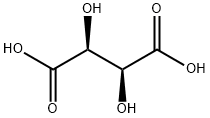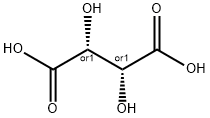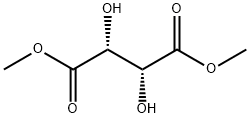D-(-)-Tartaric acid , AR,99% , 147-71-7
Synonym(s):
(2R,3R)-(+)-Tartaric acid;(2S,3S)-(-)-Tartaric acid;L- (+)-Tartaric acid;L -Threaric acid;D-(-)-Tartaric acid
CAS NO.:147-71-7
Empirical Formula: C4H6O6
Molecular Weight: 150.09
MDL number: MFCD00004238
EINECS: 205-695-6
| Pack Size | Price | Stock | Quantity |
| 100G | RMB28.80 | In Stock |
|
| 500G | RMB89.60 | In Stock |
|
| 2.5KG | RMB345.60 | In Stock |
|
| others | Enquire |
PRODUCT Properties
| Melting point: | 172-174 °C(lit.) |
| alpha | -12.1 º (c=20, H2O) |
| Boiling point: | 191.59°C (rough estimate) |
| Density | 1,8 g/cm3 |
| refractive index | -12.5 ° (C=5, H2O) |
| Flash point: | 210 °C |
| storage temp. | Store below +30°C. |
| solubility | water: soluble100mg/mL, clear, colorless |
| form | Crystals or Crystalline Powder |
| pka | 3.0, 4.4(at 25℃) |
| color | White |
| Odor | odorless |
| optical activity | [α]20/D 13.5±0.5°, c = 10% in H2O |
| Water Solubility | 1394 g/L (20 ºC) |
| Sensitive | Light Sensitive |
| Merck | 14,9068 |
| BRN | 1725145 |
| Dielectric constant | 35.9(-10℃) |
| Stability: | Stable. Incompatible with oxidizing agents, bases, reducing agents. Combustible. |
| InChIKey | FEWJPZIEWOKRBE-LWMBPPNESA-N |
| LogP | -1.081 (est) |
| CAS DataBase Reference | 147-71-7(CAS DataBase Reference) |
| NIST Chemistry Reference | D-Tartaric acid(147-71-7) |
| EPA Substance Registry System | Butanedioic acid, 2,3-dihydroxy-, (2S,3S)- (147-71-7) |
Description and Uses
D-Tartaric acid, also known as (S, S)-tartrate or D-threaric acid, belongs to the class of organic compounds known as sugar acids and derivatives. Sugar acids and derivatives are compounds containing a saccharide unit which bears a carboxylic acid group. D-Tartaric acid has been detected but not quantified in loquats (Eriobotrya japonica). This could make D-tartaric acid a potential biomarker for consuming these foods. D-Tartaric acid is a secondary metabolite. Secondary metabolites are metabolically or physiologically non-essential metabolites that may serve as defense or signalling molecules. In some cases, they are molecules that arise from the incomplete metabolism of other secondary metabolites.
D-(-)-Tartaric acid is commonly used as a resolving agent in organic synthesis. It is the synthetic enantiomer of L-(+)-Tartaric acid and is utilized in the production of synthetic analgesics. Tartaric acid is the second largest alpha hydroxy acid (AHA) in terms of size, with glycolic acid being the smallest and citric acid being the largest. It serves as a precursor for the synthesis of ester derivatives such as D-tartaric acid diethyl ester, D-tartaric acid dimethyl ester, and D-tartaric acid diiso-propyl ester. Moreover, it is employed in the creation of chiral aziridine derivative, which is a common intermediate for manufacturing hydroxyethylamine class HIV protease inhibitors like saquinavir, amprenavir, and nelfinavir. In the food industry, it is extensively used as a beer foaming agent, for regulating food acidity, and as a flavoring agent. However, due to its challenging workability and potential skin irritation, it is not frequently utilized in cosmetic or anti-aging preparations.
Safety
| Symbol(GHS) |  GHS05 |
| Signal word | Danger |
| Hazard statements | H318 |
| Precautionary statements | P280-P305+P351+P338+P310 |
| Hazard Codes | Xi |
| Risk Statements | 36/37/38 |
| Safety Statements | 26-36/37-37/39-36 |
| WGK Germany | 3 |
| RTECS | WW7875000 |
| Autoignition Temperature | 425 °C |
| Hazard Note | Light Sensitive |
| TSCA | Yes |
| HS Code | 29181200 |




